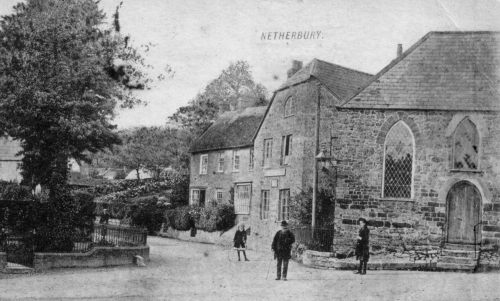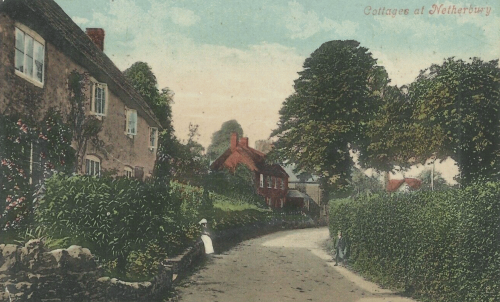The position of Japonica Cottage, right in the centre of the village and on the corner of "The Cross" a junction on what used to be the main route from Bridport to Beaminster, means this would have been an important site for many years and there would almost certainly have been a succession of dwellings there pre-dating the current house.
The property is the amalgamation of what used to be two separate plots. On the Tithe Map of 1835 the house can be clearly seen and is given the plot number 1380. There is also a row of what looks like three or four cottages just to the South, facing onto the road, which are given the plot number 1379.
Both plots were owned by different members of the Marsh family at that time – Joseph and Giles. The Marsh family in Netherbury was large and complex and, so far, it has proved impossible to work out exactly how Joseph and Giles were related. According to the 1841 census Giles' brother Aaron, 23 years old and a baker, was living nextdoor with Joseph and his family.
The row of cottages facing the road included one or more shops over the years variously recorded as a bakery, a butcher’s and a grocer’s. They are thought to have burned down in 1949 and have now been replaced with a large garage and an area of off-street parking.
Japonica Cottage itself was formerly divided into two dwellings. It became the site of the village’s second Post Office just before the end of the 1800s and remained as such for about half a century. The earliest reference to the house being called Japonica Cottage is in the Will of Fanny Martin drawn up in 1971. She had been the Postmistress at the start of WW2, having inherited the property from her mother and the job from her father. She continued living there when the Post Office moved back down Bridge Street to its last location in the General Stores (now “Greenwood”). It is probable that the house became Japonica Cottage at that point, when it could no longer be referred to as The Post Office.
Plot 1379
Plot 1379 was recorded as “Not used” in the Tithe Apportionment of 1839 when it clearly had been. Plot 1739, however, had two entries - one of which is for a small plot (10 perches, approx 250m2), described as “House & Garden”, which is both owned and occupied by Giles Marsh Jun. There can be little doubt that this is the plot to the South of Japonica Cottage and there was an administrative error in compiling the Tithe Apportionment caused by transposing two digits.
There is a Manorial Court document, dated 8th Jun 1840, granting Giles Marsh jun of Netherbury, baker, Admission to “3 dwellings, shops, stables and appurtenances near the Cross, Netherbury.” Unfortunately Giles Marsh died six months later, in Nov 1840, and was buried in St Marys graveyard.
The 1841 Census, a year later, records his wife, Elizabeth (neé Pearce), and their four children, aged 1–9 years old, in what would appear to be the same house. It gives her occupation as Grocer.
The next, recorded, owner of the plot was a John Pearce but we don’t know exactly when he acquired it. We also don’t know if, or how, he was related to Elizabeth Marsh although a John Pearce was recorded as one of the witnesses at her marriage to Giles Marsh in 1830. He is recorded as the previous CopyholdType of feudal land tenure
with duties and obligations
to the Lord of the ManorType of feudal land tenure
with duties and obligations
to the Lord of the Manor tenant to John Stoodley in the General Rentals book of the “Manor of Netherbury in Ecclesia otherwise Beaminster Parsonatus”. Stoodley is recorded as having been granted “Admission” to a dwellinghouse at Netherbury Cross (Myrtle Cottage) on 11th July 1866.
The last owner of it as a discrete plot was John Reader, a baker and grocer from Broadwindsor. According to the General Rentals book he was granted admission on 20th Dec 1867 and he still owned the CopyholdType of feudal land tenure
with duties and obligations
to the Lord of the ManorType of feudal land tenure
with duties and obligations
to the Lord of the Manor lease when he died at Loders Mill in June 1905.
A few months later on 6th January 1906 Sarah Walbridge, who already owned Japonica Cottage next-door, bought the plot from his executors (Francis Turner and John Greening) for £63 meaning she then became the owner of both plots that make up the modern day Japonica Cottage property.
At the time the southern plot consisted of a “cottage or dwellinghouse” … “now converted into two dwellings” and a “plot of ground containing about thirty six feet in length and thirty feet in breadth at the north end” on which there used to be “a dwellinghouse two shops and a well”.
This has all now been replaced by the garage and off-road car parking area of Japonica Cottage. It’s hard to know exactly when the cottages disappeared. They’re not included in the 1968 O.S. 6” to 1 mile map which was surveyed in 1961 but they are visible in various photographs published as postcards up until approx. 1920 so it must have been sometime in between.
An inscription written in pencil on the back of a framed postcard enlargement which is hanging in Netherbury’s Reading Room states that the building, a one-up one-down cottage and a butchers shop, “entirely burned down on Good Friday 1949” (April 15th).
Plot 1380
The Tithe Apportionment of 1839 lists the northern plot (No. 1380 which included the house now known as Japonica Cottage) as being owned by Joseph Marsh and occupied by Charles Legg. There is no record for Charles Legg in the 1841 census and it is thought that Joseph Marsh was occupying the house himself by then. A decade later Marsh, his wife Sarah & son Allen had moved to Fleet St, Beaminster where he remained until he died in 1885. It's not clear who occupied the house then until nearly forty years later.
An entry in the Yondover General Rental book records Joseph Marsh as being granted Admission on 13th May 1835 to two dwellinghouses at Netherbury Cross following on from Richard Keddle. A note also records that it was “Enfranchised 14th April 1879”. That would have converted Marsh’s CopyholdType of feudal land tenure
with duties and obligations
to the Lord of the ManorType of feudal land tenure
with duties and obligations
to the Lord of the Manor tenure into a Freehold ownership.
The following month, a now ageing Joseph Marsh sold the house to the Trustees and Managers of the Netherbury National School “for the purpose of using the same as a residence for the master of the said School”.
Unfortunately the Trustees and Managers of the School, all prominent and important men in the village, failed to have the purchase and transfer of ownership legally recorded.
William Dodd, the schoolmaster, occupied the property from 1879 until 1895 when William Hawkins Walbridge, “Postmaster of Netherbury”, and his family moved in. It is often stated that Japonica Cottage was the site of the first Post Office in Netherbury but by the time Walbridge moved in he had been Postmaster for at least 10 years and a detailed Ordnance Survey map, drawn up in 1888, shows the Post Office to be half way down Bridge Street.
At the end of 1899 the Trustees of the School sold the property to Sarah Walbridge but, as there was no Conveyance from when they bought it, they had to have a special Indenture drawn up. As Joseph Marsh had since died they needed confirmation from Alfred Vie Pine (the only surviving Executor of Marsh’s Will and his “personal representative”) that the property was actually theirs to sell.
William Walbridge had been declared bankrupt only five years before he moved his family and business up the road to Japonica Cottage. He paid his creditors just under 3 shillings for each pound he owed (14.9%) so it seems unlikely he’d have had the money to buy the house just under seven years later, or been in a position to borrow it, when Sarah bought it.
Sarah did not come from a wealthy background. Her father worked as a Carter or Groom and before she was married she’d lived at home with her parents in Beaminster and, like her mother, worked as a Laundress. When her father died in 1896 his entire estate was calculated to be worth £163 which was to be shared equally between all his children. There is a codicil to his Will, however, which bequeaths Sarah a half share in the payout from a Life Policy from the Clerical Medical and General Life Assurance Company. It is not known how much this amounted to but it’s tempting to speculate that it went towards her purchase of the house she was already living in three years later.
Sarah paid the School Trustees £80 and, although she was identified as the wife of William Hawkins Walbridge, the title to the property was put in her name alone, as was the other plot she bought a few years later.
This appears to have been a wise precaution as William died in 1926 without leaving a Will. A law had been passed the year before (Administration of Estates Act 1925) which meant that she would have been able to claim ownership of the property if it had been in his name but, had he died a couple of years earlier, the situation could have been much more complicated.
Japonica
In 1926 Sarah Walbridge, now a widow, paid compensation of £2 4s 10d to the “Manor of Netherbury in Ecclesia otherwise Beaminster Parsonatus”. This payment freed her of any of the old CopyholdType of feudal land tenure
with duties and obligations
to the Lord of the ManorType of feudal land tenure
with duties and obligations
to the Lord of the Manor lease terms on the southern, “1379”, plot and she now owned the property as a freehold alongside the plot she’d bought from the School Trustees which she already owned in “fee simple”. This meant the two plots were owned outright by the same person for the first time and in effect were combined into the one property we now know as Japonica Cottage.
The Walbridge family occupied Japonica Cottage for three quarters of a century and ran the Post Office up until and possibly beyond the start of the 2nd World War. William died in 1926 and Sarah remained in the house until she died four years later in 1930. Their daughter, Fanny, married Arthur Martin a few months after her father died and in the 1939 England & Wales Register her occupation was recorded as "Sub Post Mistress" and her address was The Post Office where she continued to live until she died in 1972.
The next owner was Robin Leaver who recorded the same address in Bedfordshire when he bought and sold the house, four years later in 1977, to Mr & Mrs I. G. Pollock. It is thought he never lived there himself.
A surviving sales brochure, prepared at the time, says the property was originally built “prior to 1812 (actual age unknown)”. It states that recent work carried out “has involved converting the two former cottages into a single house” and “adding a new kitchen wing” which extends the house to the north.
It also says that planning consent had been granted “for the construction of a Double Garage” which hadn’t yet been built.
Many thanks to Alison & Peter Little for their help with compiling this page.



